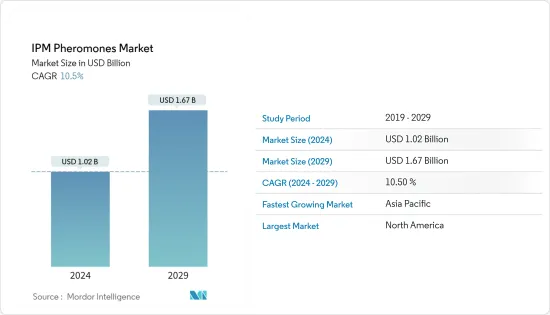PUBLISHER: Mordor Intelligence | PRODUCT CODE: 1433947

PUBLISHER: Mordor Intelligence | PRODUCT CODE: 1433947
IPM Pheromones - Market Share Analysis, Industry Trends & Statistics, Growth Forecasts (2024 - 2029)
The IPM Pheromones Market size is estimated at USD 1.02 billion in 2024, and is expected to reach USD 1.67 billion by 2029, growing at a CAGR of 10.5% during the forecast period (2024-2029).

Integrated pest management (IPM) is a science-based, sustainable decision-making approach that combines biological, chemical, physical, cultural tools and strategy to reduce the effect of pest in fields, thus minimizing overall economic, environmental and health risks associated with it.Pesticides'side effects have a serious effect on consumers and the environment. The flora and fauna are affected highly in long run. Growing awareness among consumers regarding the side effects of pesticides going to drive the IPM pheromone market. Now, a Large number of active players and distributors are involved in the production of wide range integrated pest management (IPM) pheromone market during the forecast period.
Integrated Pest Management (IPM) Pheromones Market Trends
Strong Demand for High-Value Crops
Integrated Pest Management (IPM) is an environment-friendly approach to control the pest by mechanical or biological methods without affecting the crops. The demand for organic fruits and vegetables are increasing rapidly in developing countries. The need for satisfying the nutritional and taste preferences of the population in developing countries has led to an increase in the production of organic fruits and vegetables. Our analysis shows that lately, many fruits and vegetables have tested positive for the presence of biopesticides which has decreased the demand for chemical pesticide-treated fruits and vegetables. IPM has a relatively lower residue level and is a perfect fit for the treatment of fruits and vegetables and hence fruit and vegetable forms the largest application area under IPM. Land under organic cultivation increasing with the increasing demand for fruits and vegetables. This is expected to drive the IPM pheromone market during the forecast period.
North America to Lead the Global Pheromone Market
The rising demand of certain foods and vegetable like apples, peaches, pears and cotton in North America will create growth opportunities in the global market. Rise of orchards for exports purpose will also impact the market. The market in Asia Pacific is projected to report swift growth in years to come. The rising demand for exporting agriculture products from Brazil and china may increase the pheromones market with time.
Integrated Pest Management (IPM) Pheromones Industry Overview
Major players in the segment will drive the future market,information like forecast and estimation of markets at the global level are analyzed thoroughly during the forecast period. Price estimation, drivers , year on year growth analysis, etc are extensively covered in the report. Shin-Etsu chemicals and Suterra LLC have made severalpheromones developments that are patented. Through extensive R&D in their laboratories, many major companies like Sumi Agro, Rusell IPM and Syngenta Bioline are focussing on developing new IPM pheromones.
Additional Benefits:
- The market estimate (ME) sheet in Excel format
- 3 months of analyst support
TABLE OF CONTENTS
1 INTRODUCTION
- 1.1 Study Deliverables
- 1.2 Study Assumptions
- 1.3 Scope of the Study
2 RESEARCH METHODOLOGY
3 EXECUTIVE SUMMARY
4 MARKET DYNAMICS
- 4.1 Market Overview
- 4.2 Market Drivers
- 4.3 Market Restraints
- 4.4 Porter's Five Forces Analysis
- 4.4.1 Threat of New Entrants
- 4.4.2 Bargaining Power of Buyers/Consumers
- 4.4.3 Bargaining Power of Suppliers
- 4.4.4 Threat of Substitute Products
- 4.4.5 Intensity of Competitive Rivalry
5 MARKET SEGMENTATION
- 5.1 By Type
- 5.1.1 Pheromones
- 5.1.2 Aggregation pheromones
- 5.1.3 Others
- 5.2 By Functions
- 5.2.1 Mating Disruption
- 5.2.2 Detection and monitoring
- 5.2.3 Mass Trapping
- 5.3 By Mode of applications
- 5.3.1 Traps
- 5.3.2 Prayers
- 5.3.3 Dispensers
- 5.4 By Crops
- 5.4.1 Field Crops
- 5.4.2 Vegetable Crops
- 5.4.3 Other crops
- 5.5 Geography
- 5.5.1 North America
- 5.5.1.1 United States
- 5.5.1.2 Canada
- 5.5.1.3 Mexico
- 5.5.1.4 Rest of North America
- 5.5.2 Europe
- 5.5.2.1 Germany
- 5.5.2.2 United Kingdom
- 5.5.2.3 France
- 5.5.2.4 Russia
- 5.5.2.5 Spain
- 5.5.2.6 Rest of Europe
- 5.5.3 Asia Pacific
- 5.5.3.1 India
- 5.5.3.2 China
- 5.5.3.3 Japan
- 5.5.3.4 Rest of the Asia-Pacific
- 5.5.4 South America
- 5.5.4.1 Brazil
- 5.5.4.2 Argentina
- 5.5.4.3 Rest of South America
- 5.5.5 Middle East & Africa
- 5.5.5.1 United Arab Emirates
- 5.5.5.2 Saudi Arabia
- 5.5.5.3 Rest of the Middle East & Africa
- 5.5.1 North America
6 COMPETITIVE LANDSCAPE
- 6.1 Most Adopted Strategies
- 6.2 Market Share Analysis
- 6.3 Company Profiles
- 6.3.1 Syngenta Bioline
- 6.3.2 Russell IPM
- 6.3.3 Sumi Agro France
- 6.3.4 Hercon Environmental
- 6.3.5 BASF SE
- 6.3.6 Shin-Etsu
- 6.3.7 Isagro
- 6.3.8 ISCA Technologies
- 6.3.9 Pacific Biocontrol Corporation
- 6.3.10 Suterra
7 MARKET OPPORTUNITIES AND FUTURE TRENDS




